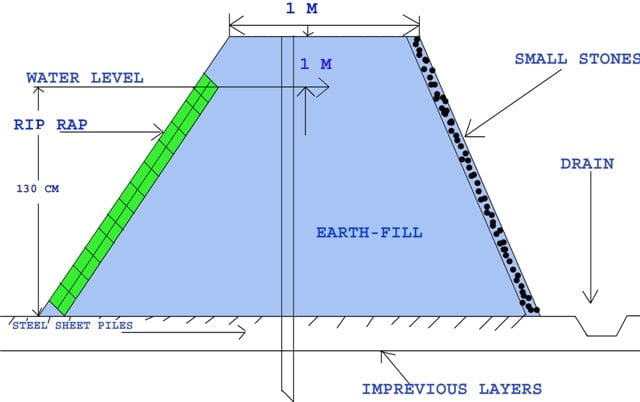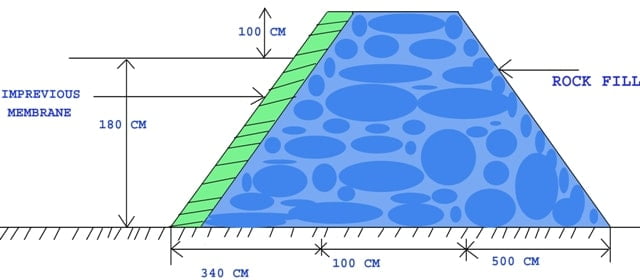The cofferdam is a temporary structure to exclude water from water-logged soil, river, or the sea to enable the excavation and construction to be carried out in the dry. Cofferdams are most commonly used to facilitate the construction or repair of dams, piers, and bridges.
The cofferdam can be made out of the earth, concrete, sheet piles, or sheet cell. There are different types of cofferdams are available.
Table of Contents
Types of cofferdams
- Earth cofferdam.
- Single sheet pile cofferdam.
- Double-wall sheet piling cofferdam.
- Rockfill cofferdam.
- Braced cofferdam.
- Cellular cofferdam.
- Diaphragm type cofferdam.
- Circular type cofferdam.
- Crib cofferdam.
Earth cofferdam
The earthen cofferdam is possible in shallow water with a low velocity of the current. The earthen bank is constructed 1 meter from the top water level. It is well suited for depths of water up to 3 meters Due to economic considerations, it is not possible to form it completely water-tight. Due to water seeping and leaking such a dam can fail. Therefore constant watch is necessary.
The bank should be a combination of clay and sand or clay and gravel. The water collected through seepage is pumped out of the excavation site to keep the construction area as dry as possible. The earth embankment cofferdams are often constructed with a minimum freeboard of about 1m to prevent waves or high tides. Sand-bag cofferdams are also used, primarily in an emergency situation.

Single sheet pile cofferdam
Single sheet piled cofferdam can be constructed by using a floating structure with machinery and crew. Single sheet piling coffer dams are generally used to enclose small foundation sites in water for bridges at a relatively small depth. In this type of cofferdams, there is a single row of cantilever sheet piles. The piles are sometimes heavily braced. Joints in the sheet piles are properly sealed.
This type of cofferdams is suitable for moderate-flow velocities of water and for depth up to 4 m. The depth of penetration below the ground surface is about 0.25h for coarse sand and gravels, 0.5h for fine sand, and 0.85h for silts, where “h” is the depth of water.
Sometimes single-sheet coffer dams are provided with earth fills on one or both sides to increase m stability. The figure of the single sheet pile cofferdam is shown on the right. Workers handling piles should wear leather gloves. A competent person should constantly supervise.
Double-wall sheet piling cofferdam
Double-wall sheet piling cofferdams are consist of two straight, parallel vertical walls of sheet piling, tied to each other, and the space between walls filled with soil. The width between the parallel piles is empirically set as (h/2 + 1.5m); where “h” is the height of water. Double-wall sheet piling coffer dams higher than 2.5m should be strutted. Sometimes, an inside berm is provided to keep the phreatic line within the berm.
The material to fill should have a high coefficient of friction and unit weight so that it performs as a massive body to give the cofferdam stability against sliding and overturning. Suitable measures should be adopted to reduce the uplift on the cofferdam. This is generally done by driving the sheet piling upstream as deep as possible.
The double-wall sheet piling cofferdam has the advantage of having less leakage than that in a single-wall cofferdam. These cofferdams are suitable up to a height of 10m.
Rockfill cofferdam
Rockfill cofferdams form of rockfill is sometimes adopted to enclose the site to be dewatered. A rock-fill cofferdam is better than an earth fill. These are permeable and are generally provided with an impervious membrane of soil to reduce seepage.
The crest and upper part of the impermeable membrane are provided with a rap to protect against the wave action. In the case of rockfill coffer dams, the overtopping does not induce serious damage. The slopes of a rockfill cofferdam can form as steep as 1 horizontal to 1.5 vertical.

Braced cofferdam
A braced cofferdam is formed by driving two rows of vertical sheeting and bracing with wales and struts. These are similar to sheeting and bracing system with one basic difference that braced cuts need for excavations in dry areas. Whereas braced cofferdams are used to isolate a working area surrounded by water. The braced cofferdams are susceptible to flood damage.
Braced cofferdams are usually adopted as land coffer dams to stop the entry of groundwater into the foundation pit and to support the soil so as to stop the cave. When the water is removed from the pit, the structural concrete. The cofferdam is removed when concreting has been completed above the water level.
Cellular cofferdam
A cellular cofferdam makes by driving sheet piles of special shapes to form a series of cells. These cells are designed to be interconnected to form a watertight wall rigid enough to retain water. The cells are filled with soil to provide a stabilizing force against lateral pressure.
This type of cofferdam is most suitable for deepwater areas, most commonly used for marine construction such as dams and wharves. Basically, two types of cellular cofferdams are commonly used. (1) Diaphragm Type (2) Circular Type
Diaphragm Type:
This type of cellular cofferdam consists of circular arcs on the inner and outer sides which are connected by straight diaphragm walls. The connection between the curved parts and the diaphragms is made by means of a specially fabricated Y-element. The cofferdam is thus made from inter-connected steel sheet piles.
The cells are filled with coarse-grained soils which increase the weight of the cofferdam and also its stability. The leakage through the cofferdam is also reduced.
To avoid the rupture of diaphragms due to unequal pressure on the two sides, it is essential to fill all the cells at approximately the same rate. One advantage of the diaphragm type is that the effective length of the cofferdam may be increased easily by lengthening the diaphragm.
Circular Type
Circular type cofferdams are consist of a set of large diameter circular cells interconnected by an area of smaller diameter. The walls of the connecting cells are perpendicular to the walls of the main circular cells of large diameter. The segmental arcs are joined by special T-piles to the main cells.
The circular type cellular cofferdams are self-sustaining, and therefore independent of the adjacent circular cells. Each cell can be filled independently. The stability of such cells is much greater as compared with that of the diaphragm type.
However, the circular cells are more expensive than the diaphragm type, as these require more sheet piles and greater skill in setting and driving the piles. Because the diameter of circular cells is limited by interlock tension, their ability to resist lateral pressure due to high heads are limited.
After erecting the cofferdam, the inside water is pumped out. The excavation is done in dry soil up to sound strata, the foundation is laid down and the structure is built. The cofferdam is dismantled thereafter.
Crib cofferdam:
Crib cofferdam Constructed on land and floated into place. The lower portion of each cell is matched with the contour of the river bed. It uses rock ballast and soil to decrease seepage and sink into place, also known as “Gravity Dam”.
It usually consists of 12’x12’ cells. It must be properly designed to resist lateral forces such as tipping/overturning and sliding. This is commonly used in deep waters where the ground is particularly hard. A crib is a framework of wooden horizontal & cross beams. This crib is open at the bottom and is filled with rock or earth.
Difference between cofferdam and caissons
The main difference between the caissons and cofferdams is that the caissons are permanent structures and form an integral part of the bridge or building foundation and cofferdam is a temporary structure that is removed after work is completed. A caisson is a box-type structure to be used as a part of the foundation.
Both caissons and cofferdams are water-tight structures used in underwater constructions or repairs of dams, piers, and bridges. Caissons are made of a material such as timber, steel, masonry, and reinforced concrete, etc. The caissons are of three types.
Types of caissons
Box caisson
A box caisson is closed at the bottom but opens at the top to the atmosphere. The box caisson is possible where no much excavation is required underwater. The box is prepared of concrete or stone masonry.
Open caisson
An open caisson is open at both ends. The open caisson is a hollow cylinder or rectangular hollow shaft made of timber, masonry, or RCC. Its bottom edge is V-shaped and it is also known as cutting edge.
Pneumatic caisson
A pneumatic caisson has a working chamber with a roof in which air pressure is maintained to prevent the entry of water and soil into the excavation. Where open caisson is not possible, the pneumatic caisson is created by compressed air to drive water out of the working space for men and voids in the material which is being excavated and thereby making the inside dry for easy working.
